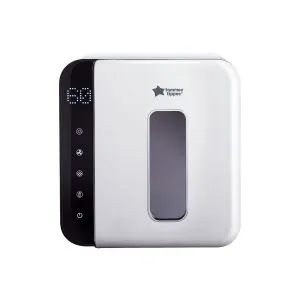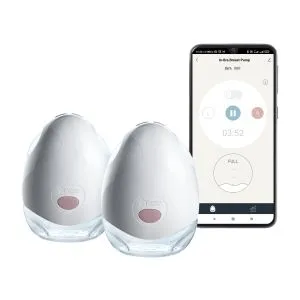
Tommee Tipps
We’ve put together this guide to put your mind at ease and to help your little one move from their beloved bottle to a cup with as little fuss as possible.
Transitioning Your Baby From Bottles to Cups: A Quick Guide
Some babies build a strong bond with their bottle. So it’s understandable that the idea of transitioning away from it and towards a cup can be emotional and worrying for parents and caregivers!
We’ve put together this guide to put your mind at ease and to help your little one move from their beloved bottle to a cup with as little fuss as possible.
Why do they need to move on from a bottle?
Little ones should transition from bottle to cup because…
- Prolonged bottle use increases the risk for tooth decay and can lead to dental issues like an overbite or tooth protrusion.
- Toddlers tend to use their bottles for comfort (just like pacifiers) rather than because they’re hungry or thirsty. As they develop and move on from drinking from a bottle, it’s important to teach them how to manage and vocalise their feelings in other ways.
- Drinking from a bottle can encourage snacking behaviour. In time, this can contribute to excessive weight gain, or for some toddlers, poor growth, and a lack of important nutrients if they rely on a bottle instead of solid foods.
- Prolonged bottle use increases the potential for delays in speech development.
- Drinking from a bottle while lying down can lead to an increased risk of ear infections.
There's no need to become overwhelmed by the thought of moving your mini-me on from their bottle. But it’s good to be aware of the reasons why you should eventually ditch bottles so you can start supporting them through the change early on.
When to start transitioning from a bottle to a cup
Little ones can begin drinking water alongside their first meals from six months of age, regardless of whether they're breastfed, formula-fed, or combination fed. That means you can start weaning them away from their bottle anywhere between six and 12 months.
Before you begin the transition, you should make sure that your baby can sit up and hold their head steady independently.
From around one year old, the Department of Health (DOH) recommends that all drinks should be served in a cup.
Having patience is key. Starting early with the transition can also help little ones learn all about sipping, while also supporting the development of their hand-eye coordination and strengthening their facial muscles.
You should bear in mind that every child's development timeline is unique, so don’t be tempted to compare your little one to others. They will get there in their own time!
What sort of cup should I choose?
It's really up to you!
You can choose to use a sippy cup with a spout, or one with a silicone straw – either is fine. It’s usually just a matter of testing to see which type of baby cup works best for your baby. A cup with handles on either side can be helpful until they’ve developed a stronger grip.
Once your little one has mastered sipping and can control their cup without too many spills, you can move them from a lidded beaker to a grown-up open cup.
How to transition from a bottle to a cup
Moving on from a bottle to a cup doesn't mean that you need to stop giving your child breastmilk or formula if you don't want to. Sometimes, offering water in a cup straight away can make the transition tougher, so some parents like to give their little one milk in a cup first to encourage them to start drinking from one before they transition to drinking water.
Remember that it's a process and something that will take time. It may be messy, with some spills along the way, but these 10 top tips should help you succeed…
1. Think about the timing of the transition
It's important to remember that your baby’s bottle is a source of comfort for them. That means trying to wean them off when they're feeling unwell or going through a routine change (like going to a new childminder) might not go to plan.
2. Let them copy you
Try popping your little one in their highchair at mealtime and offer them some breastmilk or formula in a cup. That way, they will get used to sitting at the table to drink, and they’ll start to mimic how you drink from a glass.
3. Transition from milk to water gradually
Try diluting their milk a little more each time to help them get used to drinking water. To cut their bottles out gradually, start by swapping the mid-day bottle first, then morning, then evening – waiting a few days or a week in between each stage.
Make your little one aware of the change by telling them that, although they’re used to their bottle, they’re growing up and now have a shiny new cup with water in – how exciting!
4. Out with the old, in with the new
Keep their old bottles out of sight and instead, put their colourful new cups on display.
5. Make it fun
Why not tell your little one that the Bottle Fairy is coming to visit and bringing them some nice new cups in exchange for their old bottles? Or, if it's Christmas time, perhaps Santa will come and swap their bottle for an exciting present!
6. Remember to be patient
Give lots of praise, and be affectionate – think more hugs, playtime, and extra stories at bedtime!
7. Start early
Gradually reducing the amount of milk offered in a bottle and introducing cups at an early age will help toddlers be best prepared for their weaning journey.
8. Reduce the night-time feeds
Night-time feeds can be the most damaging to your toddler’s teeth. Reducing these not only helps protect their teeth but can allow them to move more into a ‘big kid’ feeding schedule. Try giving them their last feed in another room (other than their nursey) to make time between feeds and bed and stop that association.
9. Understand they may have an emotional attachment
If they do have an attachment to their bottle, try to comfort them in other ways, such as with stories, cuddles or by giving them their favourite toys.
10. Give them other calcium-rich foods
If you’re concerned the move from bottle to cup will reduce their calcium intake, be sure to give them plenty of calcium-rich snacks instead, such as cheese and yoghurts.
To wrap up, when you're transitioning from bottle to cup, it’s important to think about your little one’s unique temperament, and don’t worry if your first try doesn’t quite go to plan.
If you're struggling, you can always reach out to your doctor or a dedicated paediatric dietitian for advice.
What should my little one drink once they're used to their cup?
Try sticking to putting only water in your baby's cup if you can. Sugary drinks like fruit squash, carbonated beverages, milkshakes, and fruit juice can trigger tooth decay. Children under three years of age should not have anything that contains artificial sweeteners.
If you do offer them fruit juice or squash, dilute it with water (this should be 10-parts water to just one-part juice). Serve this alongside a meal to help minimise the risk of tooth decay.
It’s also handy to know that after the age of six months, it’s fine to give your child water from the tap without sterilising it first. But you should always make sure that you clean all parts of your baby’s cup thoroughly and pay extra attention to any spouts or valves.
Resources
Healthline has lots of information about drinks and cups for babies and young children.











